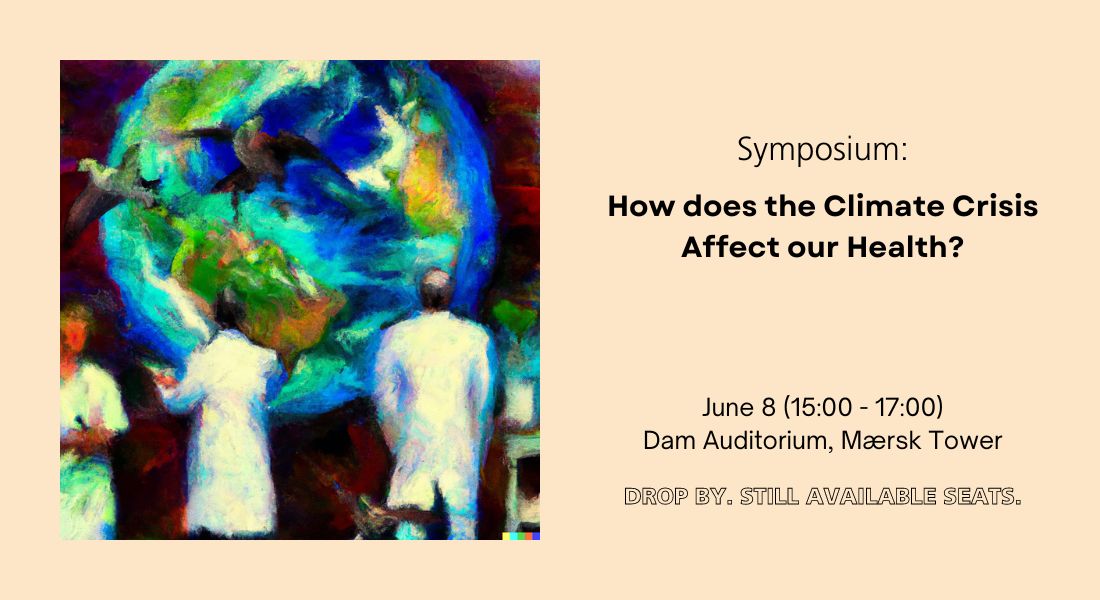Symposium: How does the Climate Crisis Affect our Health?

NEW AUDITORIUM: We have moved the event to the Dam Auditorium (same building, just further down the hall. See map)
Hear health science professors discuss how climate change creates health challenges and affects human well-being. The aim of the symposium is to raise awareness of the connection between climate and health, so that in the future we can reduce the consequences of the climate crisis for public health.
Programme
| 15:00 | Welcome |
| 15:05 | Are climate change solutions also global health solutions? by Associate Professor Britt Pinkowski Tersbøl |
| 15:30 | Biodiversity crisis threatens drug development from medicial plants by Full Professor David Nogués-Bravo |
| 15:55 | Break |
| 16:05 | Climate alternations and risk of zoonotic disease by Professor Jens Lundgren |
| 16:30 | Q&A session |
| 16:55 | Thank you for coming |
Register for the symposium
More about the talks
Speaker: Britt Pinkowski Tersbøl, Associate Professor, Department of Public Health
Title: Are climate change solutions also global health solutions?
Abstract: Climate change will impact global health and societies in profound ways. Although Earth has experienced global warming pre-historically, the current rate of temperature increase is unprecedented. Rising global temperatures cause changes in natural environments on all continents, but some regions are more affected than others, rendering its populations vulnerable to a wide range of serious calamities and health-related hazards. This presentation will touch on some of the global health challenges associated with climate change and discuss the assumption that climate change solutions are also global health solutions, why that is - and also, why may not be the case. The presentation will consider what previous climate change events may teach us about how to build resilience and protect each other.
Speaker: David Nougés-Bravo, Professor, Globe Institute
Title: Biodiversity crisis threatens drug development from medicial plants
Abstract: Medicinal plants and their bioactive molecules are integral components of nature and have supported the health of human societies for millennia. However, the prevailing view of medicinal biodiversity solely as an ecosystem decoupled natural resource of commercial value prevents people from fully benefiting from the capacity of nature to provide medicines and from assessing the vulnerability of this capacity to the global environmental crisis. Emerging scientific and technological developments and traditional knowledge allow for appreciating medicinal plant resources from a planetary health perspective. In this Personal View, we highlight and integrate current knowledge that includes medicinal, biodiversity, and environmental change research in a transdisciplinary framework to evaluate natural medicinal resources and their vulnerability in the anthropocene. With Europe as an application case, we propose proxy spatial indicators for establishing the capacity, potential societal benefits, and economic values of native medicinal plant resources and the exposure of these resources to global environmental change. The proposed framework and indicators aim to be a basis for transdisciplinary research on medicinal biodiversity and could guide decisions in addressing crucial multiple Sustainable Development Goals, from accessible global health care to natural habitat protection and restoration.
Speaker: Jens Lundgren, Professor, Department of Clinical Research
Title: Climate alternations and risk of zoonotic disease
Abstract: All recent pandemics developed due to transfer of pathogens (typically viruses) from animals to humans (so called zoonotic infections). Such pathogens evolve in their natural host and the transfer occur either via direct contact or via an intermediate host. Each pathogen has its unique non-human host(s). The probability of transfer depends on how closely humans interact with the natural or intermediary host. Key factors affecting closeness includes population density in areas where the non-human host lives, animal domestication, and environmental factors including climate temperature propagating wild-life breading of the host.
